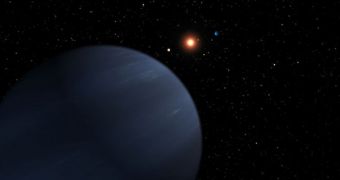In a new study, astronomers have determined that the presence of dark matter can have a beneficial effect on extrasolar planets that are too far away from their parent stars to receive heat.
High temperatures are considered to be one of the most important prerequisites for the development of life. As such, experts have widely agreed that only planets in their stars' habitable zones can be considered as potentially harboring life.
However, such exoplanets are rare. Now, scientists propose a new idea, that may boost the number of planets that could potentially support life, even in the absence of warm-enough light from their stars.
According to investigators, large amounts of dark matter may contribute to heating cold, desolate planets, making them just warm enough to allow for the development of basic lifeforms.
There are several sources (except starlight) that can heat planets. On Earth, some 0,025 percent of the planet's geothermal energy comes from the decay of radioactive elements in its crust, mantle and core.
Celestial bodies such as Saturn's moon Titan could be warmed via a greenhouse gas effect, if they have a very thick atmosphere. On other objects, thick shells of ice may be protecting life that developed when those respective worlds were younger and hotter.
Experts from the Fermi National Accelerator Laboratory (Fermilab), led by physicists Dan Hooper and Jason Steffen explain that dark matter may in fact be an exotic internal radiator for exoplanets. At selected locations throughout the galaxy, this type of matter may outshine entire stars.
“It’s not something that’s likely to produce a lot of habitable planets. But in very special places and in very special models, it could do the trick,” Hooper explains. A paper the two experts authored has been submitted for publication in an upcoming issue of the esteemed Astrophysical Journal.
The team bases its explanation on the supposition that dark matter is made up of weakly interacting massive particles (WIMP) – this is one of the most popular theories in the scientific community.
These particles are also their own antiparticles, which means that they annihilate each other violently whenever they meet. This process gives rise to an impressive burst of energy. If this happens inside an exoplanet, enough heat would be generated to melt ices on the surface.
“This is a fascinating, and highly original idea. Original ideas are becoming more and more rare in exoplanet theory,” says exoplanet expert Sara Seager, who was not a part of the research. She is based at the Massachusetts Institute of Technology (MIT), in Cambridge.
“You can imagine planets being heated in this sort of way for literally trillions of years,” adds Hooper.
“In the far future when all the stars have burnt out in our galaxy, all the surviving civilizations may find themselves migrating to these sorts of planets. They’ll be the ultimate bastion of civilization,” he concludes, quoted by Wired.

 14 DAY TRIAL //
14 DAY TRIAL //